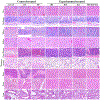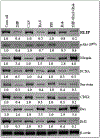Synergistic efficacy of RLIP inhibition and 2'-hydroxyflavanone against DMBA-induced mammary carcinogenesis in SENCAR mice
- PMID: 31006917
- PMCID: PMC8742507
- DOI: 10.1002/mc.23026
Synergistic efficacy of RLIP inhibition and 2'-hydroxyflavanone against DMBA-induced mammary carcinogenesis in SENCAR mice
Abstract
Substantial evidence suggests that 7,12-dimethylbenzanthracene (DMBA)-induced mammary carcinogenesis in mice mimics human breast cancer (BC) in many respects. Therefore, it has been used extensively to evaluate preventive and therapeutic agents for human BC. Mammary carcinogenesis induced by DMBA administration in female SENsitive to CARcinogen (SENCAR) mice was characterized by histopathological analysis of the mammary glands and alterations to the phosphatidylinositol 3-kinase/protein kinase B/cyclin-dependent kinase 1 (PI3K/Akt/CDK1) pathway. We recently reported that 2'-hydroxyflavanone (2HF) is a promising diet-derived chemotherapeutic agent that suppresses BC growth in vitro and in vivo by targeting a 76 kDa ral-interacting protein (RLIP). The objective of the current study was to investigate the synergistic anticarcinogenic effects of RLIP inhibition/depletion and 2HF in an in vivo model of DMBA-induced mammary carcinogenesis in SENCAR mice. Mice were given 2HF (50 mg/kg, bw, orally on alternate days), RLIP antibody (Rab; 5 mg/kg, bw, ip weekly), RLIP antisense (RAS; 5 mg/kg, b.w., ip weekly), or a combination of 2HF + Rab + RAS. Animals were monitored daily, and 7 days after the first appearance of moribund behavior, tissues were harvested for morphological and immunohistological analysis. Western blot analyses were performed to determine the expression of anti- and proapoptotic proteins in the mammary glands. Our results reveal that 2HF, RAS, and Rab significantly prevented the carcinogenic effects of DMBA administration in the mammary glands and other organs. Further, mice treated with a combination of 2HF + RAS + Rab exhibited no carcinogenic effect of DMBA as compared to either or the single agent-treated mice. This study demonstrates for the first time the anticarcinogenic effects of 2HF and RLIP inhibition/depletion in vivo in a novel DMBA-induced model of BC in SENCAR mice and provides the rationale for further clinical investigation.
Keywords: DMBA; RLIP; chemotherapeutics; mammary gland; mercapturic acid pathway transporter; phytochemicals.
© 2019 Wiley Periodicals, Inc.
Conflict of interest statement
Figures




Similar articles
-
Prevention of mammary carcinogenesis in MMTV-neu mice by targeting RLIP.Mol Carcinog. 2021 Mar;60(3):213-223. doi: 10.1002/mc.23285. Epub 2021 Feb 5. Mol Carcinog. 2021. PMID: 33544936 Free PMC article.
-
RLIP inhibition suppresses breast-to-lung metastasis.Cancer Lett. 2019 Apr 10;447:24-32. doi: 10.1016/j.canlet.2019.01.023. Epub 2019 Jan 23. Cancer Lett. 2019. PMID: 30684594 Free PMC article.
-
Metastasis of breast tumor cells to brain is suppressed by targeting RLIP alone and in combination with 2'-Hydroxyflavanone.Cancer Lett. 2018 Dec 1;438:144-153. doi: 10.1016/j.canlet.2018.09.015. Epub 2018 Sep 15. Cancer Lett. 2018. PMID: 30223070 Free PMC article.
-
RLIP: An existential requirement for breast carcinogenesis.Biochim Biophys Acta Rev Cancer. 2019 Apr;1871(2):281-288. doi: 10.1016/j.bbcan.2019.02.001. Epub 2019 Feb 13. Biochim Biophys Acta Rev Cancer. 2019. PMID: 30771458 Review.
-
Chemoprevention with protein kinase A RIalpha antisense in DMBA-mammary carcinogenesis.Ann N Y Acad Sci. 2005 Nov;1058:255-64. doi: 10.1196/annals.1359.038. Ann N Y Acad Sci. 2005. PMID: 16394142 Review.
Cited by
-
Rlip Depletion Alters Oncogene Transcription at Multiple Distinct Regulatory Levels.Cancers (Basel). 2022 Jan 21;14(3):527. doi: 10.3390/cancers14030527. Cancers (Basel). 2022. PMID: 35158795 Free PMC article.
-
Recent Advancement in Breast Cancer Research: Insights from Model Organisms-Mouse Models to Zebrafish.Cancers (Basel). 2023 May 29;15(11):2961. doi: 10.3390/cancers15112961. Cancers (Basel). 2023. PMID: 37296923 Free PMC article. Review.
-
Liquid chromatography-tandem mass spectrometry analysis of oxidation of 2'-, 3'-, 4'- and 6-hydroxyflavanones by human cytochrome P450 enzymes.Xenobiotica. 2021 Feb;51(2):139-154. doi: 10.1080/00498254.2020.1836433. Epub 2020 Oct 23. Xenobiotica. 2021. PMID: 33047997 Free PMC article.
-
Targeting RLIP with CRISPR/Cas9 controls tumor growth.Carcinogenesis. 2021 Feb 11;42(1):48-57. doi: 10.1093/carcin/bgaa048. Carcinogenesis. 2021. PMID: 32426802 Free PMC article.
-
Prevention of mammary carcinogenesis in MMTV-neu mice by targeting RLIP.Mol Carcinog. 2021 Mar;60(3):213-223. doi: 10.1002/mc.23285. Epub 2021 Feb 5. Mol Carcinog. 2021. PMID: 33544936 Free PMC article.
References
-
- Shimkin MB, Gropper L, Thatcher D, Gruenstein M. Hormonal treatment of mammary tumors in rats induced by 3-methylcholanthrene (NSC-21970) and 7,12-dimethylbenz(alpha)anthracene (NSC-408823). Cancer Res 1967; 27: 1284–1288. - PubMed
-
- Medina D, Butel JS, Socher SH, Miller F. Mammary tumorigenesis in 7,12-dimethylbenz-anthracene treated C57BL x DBA/2f F1mice. Cancer Res 1980; 40: 368–373. - PubMed
-
- Medina D, Lane HW, Shepherd F. Effect of dietary selenium levels on 7,12-dimethylbenz-anthracene-induced mouse mammary tumorigenesis. Carcinogenesis 1983; 4: 1159–1163. - PubMed
-
- Fischer SM, Conti CJ, Locniskar M, Belury MA, Maldve RE, Lee ML, et al. The effect of dietary fat on the rapid development of mammary tumors induced by 7,12-dimethylbenz(a)anthracene in SENCAR mice. Cancer Res 1992; 52: 662–666. - PubMed
-
- Qing W-G, Conti CJ, LaBate M, Johnston D, Slaga TJ, MacLeod MC. Induction of mammary cancer and lymphoma by multiple, low oral doses of 7,12-dimethylbenz(a)anthracene in SENCAR mice. Carcinogenesis 1997; 18: 553–559. - PubMed
Publication types
MeSH terms
Substances
Grants and funding
LinkOut - more resources
Full Text Sources
Miscellaneous

